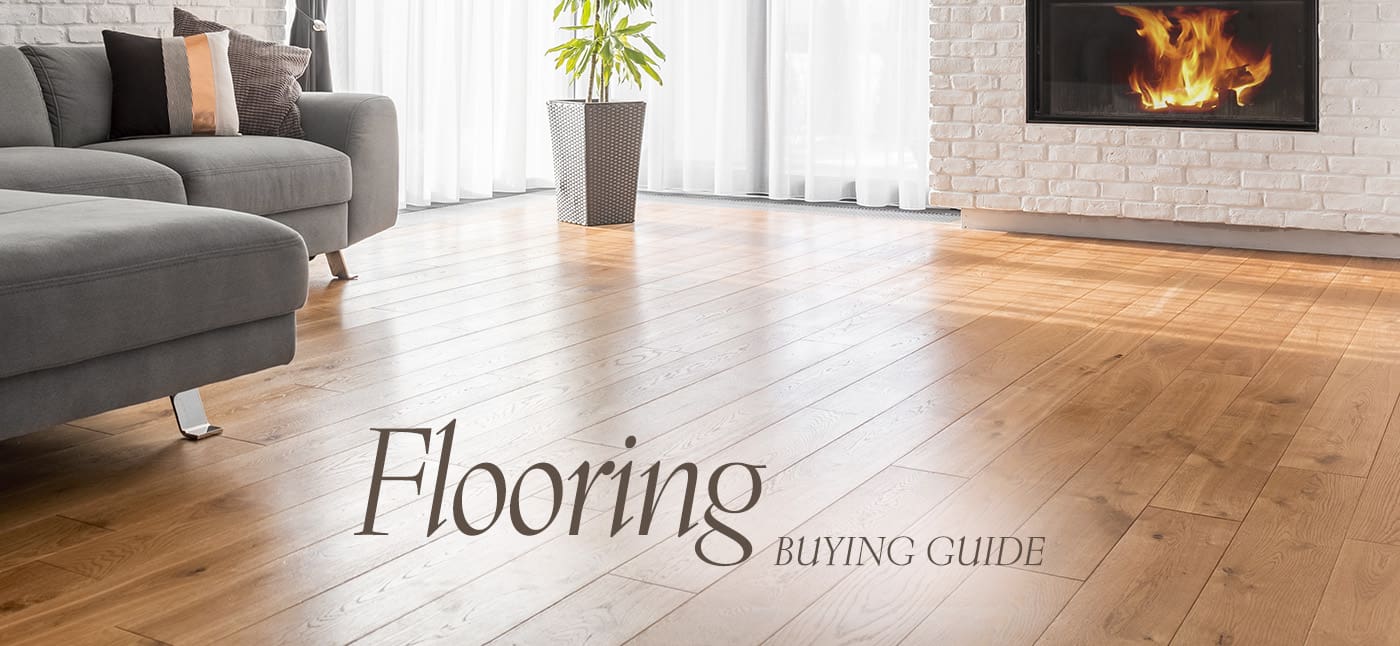Flooring Buying Guide
Floors are arguably the biggest design element in your home, and they have a huge impact on the look and feel of every room. Whether you’re playing with your dog, hosting guests for dinner, or teaching your toddler to walk, you need flooring that’s durable and attractive, and perfectly suited to your needs. No matter what type of new flooring you choose, you want it to look good and perform well for many years to come, which is why it’s such an important decision. At Costco, we want to make that decision as easy as possible. That’s why we’ve constructed this buying guide, to help you choose the best flooring for every room in your home!
What Type of Flooring Should I Buy?

Laminate
Originally created as an affordable alternative to hardwood, laminate flooring was specifically designed to mimic the look of real wood. Laminate is a multi-layer synthetic flooring, often composed of materials like melamine, fiber board, wood, and plastic, which are fused together to form an incredibly tough product. It is finished with a top layer that features a photographic image sealed with a hard protective topcoat. Laminate is one of the strongest, most scratch-resistant and impact-resistant materials available, which is why it is such a popular choice for households with animals and children. Laminate flooring is available in a wide variety of wood grains, widths and finishes, from traditional oak to exotic bamboo.
Shop Laminate Flooring
Installation & Care
Before installation, always thoroughly read and adhere to the installation instructions and maintenance guidelines provided by the manufacturer. Laminate is typically available in easy-to-use interlocking planks that click together securely, requiring no nails, grout, or adhesives. This type of installation is referred to as a “floating floor”, because the laminate is not secured to the subfloor underneath. Laminate can often be installed over existing flooring, as long as the subfloor is sound, level and has no moisture issues. Proper maintenance of laminate flooring requires regular cleaning with a dust mop, broom, or hard floor vacuum, which will help prevent abrasive dirt from scratching the floor's surface layer. You can also use a damp mop with water only. If you need a more thorough cleaning, you can use a solution of water with vinegar or a non-sudsing ammonia. Do not pour liquid directly on floor. Although most brands of laminate are either waterproof or have a moisture-resistant topcoat, it‘s still best to clean up spills quickly. Never use a steam cleaner on laminate floors. To help prevent scratches from daily activity, it’s a good idea to put protective felt pads under the legs of furniture.
Pros & Cons
Laminate is a very cost-effective flooring option. It is one of the most durable types of flooring available, which makes it a smart choice for people with high-traffic households. It is an extremely tough flooring that if properly cared for, will perform well for many years. Unlike solid or engineered hardwood flooring, laminate cannot be sanded or refinished. Length of acclimation time can vary by manufacturer, but for best results, acclimate 48-72 hours prior to installation.
Installation difficulty level: Novice
- Affordable
- Strong & highly durable
- Scratch-resistant
- Impact-resistant
- Fade-resistant
- Moisture-resistant or waterproof
- Sounds & feels like hardwood
- DIY or professional installation
- Available in numerous wood grains, widths & finishes
- Maintains it’s finish. No refinishing or waxing ever.
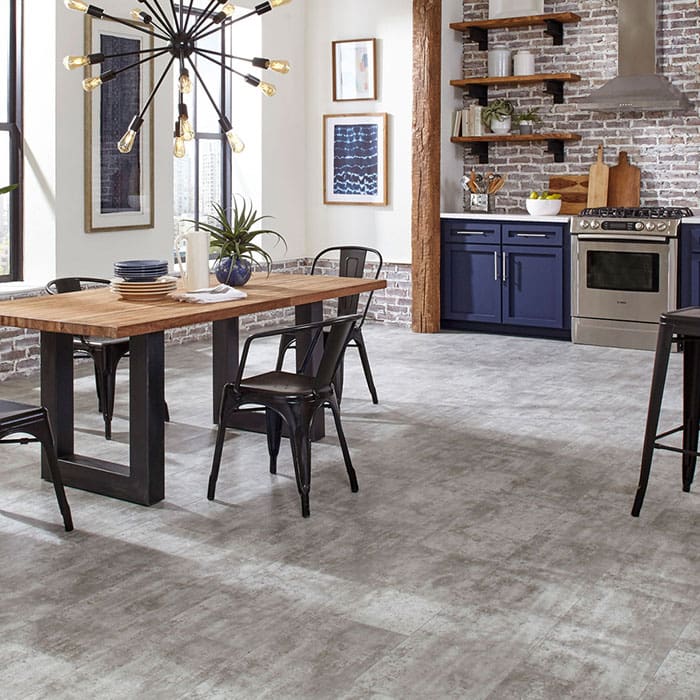
Vinyl
With the many advancements in technology and appearance, today’s luxury vinyl flooring has emerged as a stylish and popular choice for homeowners. Designed to look like real wood or natural stone, this durable material is available in sheets, planks, and individual tiles, and comes in a limitless array of colors, patterns, and widths. This smooth and resilient plastic flooring is made from a specialized blend of PVC, plasticizers, stabilizers, and vinyl resins, and boasts a unique waterproof backing that prevents mold and mildew. It is finished with a transparent top-coat for long-lasting durability. It is water-proof and highly resistant to scratches and dents, and can be placed almost anywhere in your home—even bathrooms, basements and kitchens!
Shop Vinyl Flooring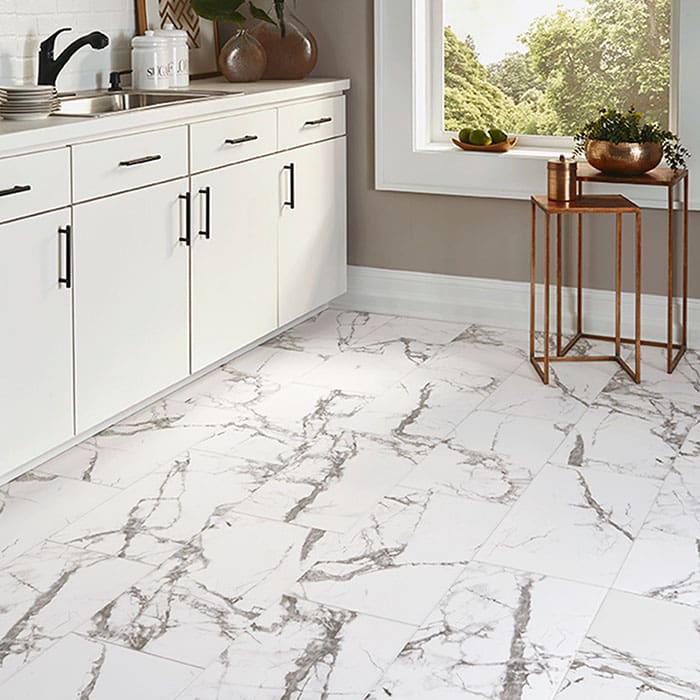
Installation & Care
Before installation, always thoroughly read and adhere to the installation instructions and maintenance guidelines provided by the manufacturer. Some types of vinyl flooring are installed using a peel-and-stick method to adhere it to the subfloor underneath. But most luxury vinyl planks and tiles come with simple interlocking tongue-and-groove edges that are cut to easily fit together, and require no nails, grout, or adhesives. In most instances, vinyl can be laid directly on top of the existing floor. If installed correctly, luxury vinyl flooring is extremely water-resistant. Maintaining a vinyl floor requires frequent sweeping to prevent grit from being ground into the vinyl. You can also use a vacuum, as long as it does not have a rotary brush or beater bar, which can leave scratches. For a more thorough cleaning, you can use a gentle mixture of warm water and mild soap. High temperatures can damage vinyl, so if you use a steam mop, ensure that it’s set on a low-level of heat. To help prevent scratches from daily activity, it’s a good idea to put protective felt pads under the legs of furniture.
Pros & Cons
Vinyl flooring is very affordable and durable, making it a great option for people with kids, pets, or high-traffic households. It’s long-lasting, and helps to muffle common household noises. Due to its high water-resistance, vinyl flooring is a great choice for bathrooms, laundry rooms, basements and kitchens. Installation can be done quickly and usually requires minimal prep-work. Long-term exposure to direct sunlight can cause some types of vinyl to fade. Vinyl is not a biodegradable material. Length of acclimation time can vary by manufacturer, but for best results, acclimate 48-72 hours prior to installation.
Installation difficulty level: Novice
- Very affordable
- Highly durable
- Water-proof
- Dent-resistant
- Noise buffering
- Easy DIY installation (limited tools required)
- Available in numerous colors, patterns, & widths
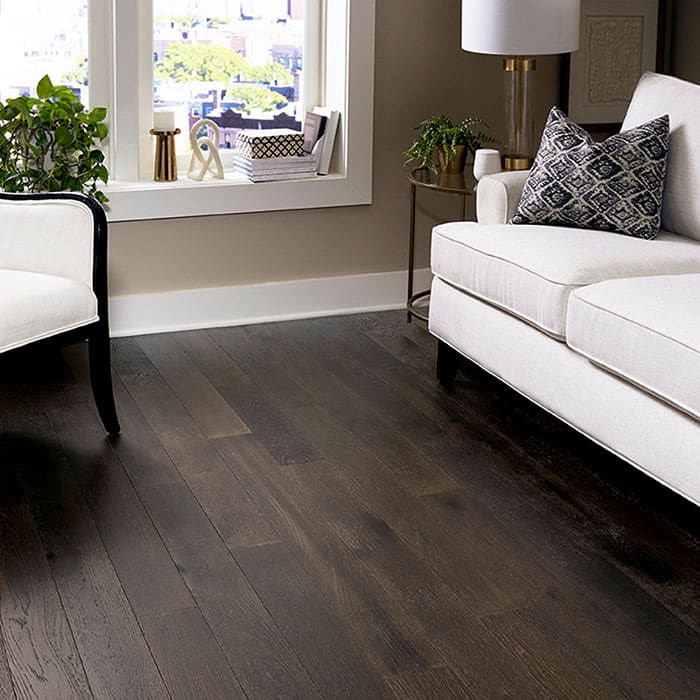
Engineered Hardwood
When it comes to wood flooring, engineered hardwood can be a more affordable option than solid hardwood, while still offering the same elegant look and feel. Engineered hardwood is a durable multi-layered product that features a thin surface layer of real hardwood, pressed together and bonded with under-layers of high-quality plywood, fiberboard, or polymer composite. The finished product is an incredibly hard, durable, and long-lasting type of flooring that once installed, looks identical to solid hardwood. It is typically sold pre-finished, with a water-resistant or water-proof sealer applied to the top. Engineered hardwood is available in a wide variety of wood grains, widths and finishes, so you can easily find something that suits your style.
Shop Engineered Hardwood Flooring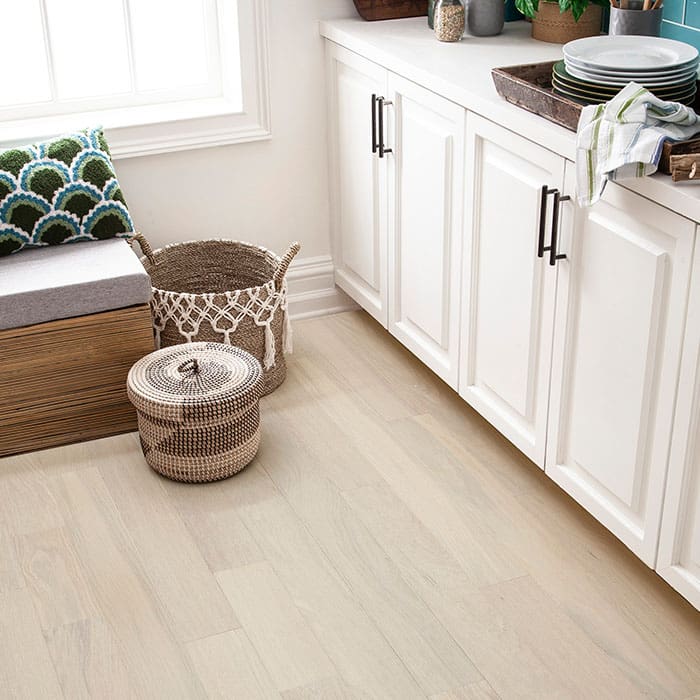
Installation & Care
Before installation, always thoroughly read and adhere to the installation instructions and maintenance guidelines provided by the manufacturer. Engineered hardwood is fast and easy to install, and can usually be placed directly over an existing floor, as long as the subfloor is sound, level, and free of moisture. Some engineered hardwood floors use interlocking planks that click together and stay in place, and require no nails or adhesives. This type of installation is referred to as a “floating floor”, because the planks are not secured to the subfloor underneath. Some people feel comfortable installing engineered hardwood, but if you’re not sure, it’s best to have a professional do the job. Maintenance requires frequent cleaning with a broom or hard floor vacuum. A damp mop can be used if needed, as well as the appropriate wood cleaners. It’s best to clean up spills quickly, and not allow water to pool or sit on the floor. Do not use a wet vacuum or steam cleaner on engineered hardwood floors. To help prevent scratches from daily activity, it’s a good idea to put protective felt pads under the legs of furniture.
Pros & Cons
Solid hardwood and engineered hardwood flooring look identical once they are installed, so choosing one over the other is simply a matter of budget and personal preference. In comparison to solid hardwood, engineered hardwood is typically less expensive and is much easier to install. It also handles temperature fluctuations and moisture better than solid hardwood flooring, making it less prone to splitting or warping. It’s important to note that engineered hardwood is harder to repair than solid hardwood. Acclimation times can vary by species, but for best results engineered and hard wood flooring should acclimate for at least 3 days.
Installation difficulty level: Experienced / Professional
- Highly durable
- Long-lasting
- Heat-resistant
- Typically sold pre-finished
- Looks identical to solid hardwood flooring
- Not all types require professional installation
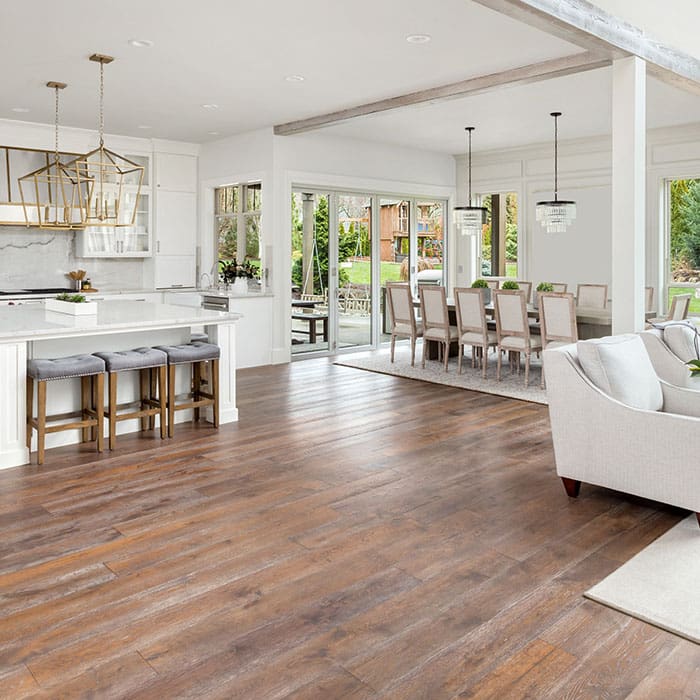
Solid Hardwood
There’s nothing that compares to the natural beauty of solid hardwood flooring. It’s hardy and resilient, and has a luxurious look and feel that appeals to many homeowners. Most people install hardwood flooring simply because they love the look of it, while others choose hardwood because it can last a lifetime. Real hardwood flooring is made of thick solid planks from durable species of deciduous trees, such as oak, maple, poplar, walnut, or hickory. The thick planks can be sanded and refinished numerous times before they need to be replaced. No matter what your reasons may be, upgrading your floors to solid hardwood is a smart investment that will considerably increase the value of your home.
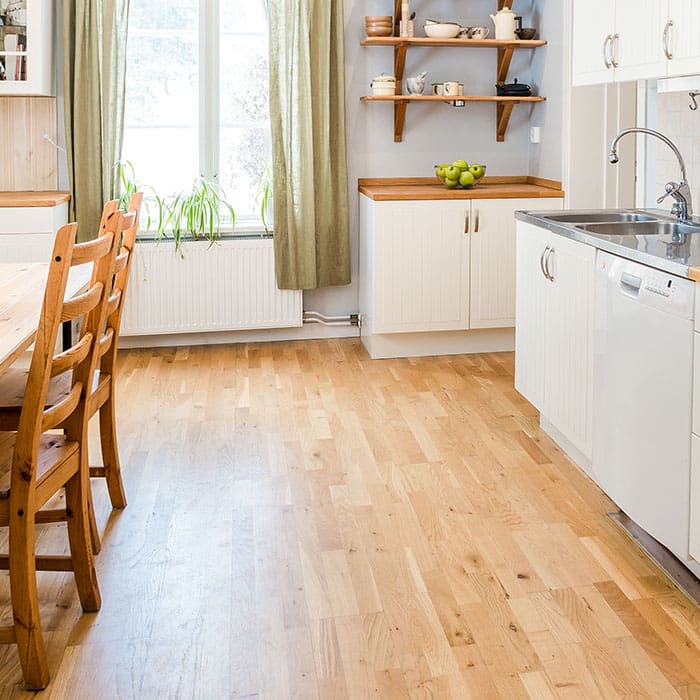
Installation & Care
Before installation, always thoroughly read and adhere to the installation instructions and maintenance guidelines provided by the manufacturer. To help avoid buckling, gaps and other issues, it's best not to install solid hardwood over an existing floor. A hardwood floor is typically installed over a sub-layer of plywood. During installation, planks are usually nailed to the plywood subfloor, and in some cases, a layer of glue will be used as well. Considering the level of difficulty involved with installation, it’s probably best to have an experienced professional do the job. You can maintain hardwood floors with frequent cleaning using a broom or hard floor vacuum. To avoid warping and staining, it’s best to clean up spills quickly with a damp cloth. You can lightly mop hardwood floors using a solution of warm water and gentle liquid soap. Appropriate wood cleaners can also be used. Never use a wet vacuum or steam cleaner on solid hardwood floors. To help prevent scratches from daily activity, it’s a good idea to put protective felt pads under the legs of furniture.
Pros & Cons
There’s no doubt that solid hardwood flooring has many benefits. Its hardiness and timeless appeal can help elevate the look and resale value of your home. If you damage hardwood or want to change the color of the stain, it can be sanded and refinished. Solid hardwood flooring is usually more expensive than engineered hardwood or laminate, and has some drawbacks. It does not do well with high humidity or fluctuating temperatures, which can cause planks to shrink or swell, and extended exposure to water can cause hardwood planks to permanently warp. Acclimation times can vary by species, but for best results engineered and hardwood flooring should acclimate for at least 3 days.
Installation difficulty level: Experienced / Professional
- Durable
- Very long-lasting
- Thick solid composition
- Can be sanded & refinished numerous times
- Increases the resale value of your home
- Typically requires professional installation
How to Measure for Flooring
Good quality flooring can be pricey, which is why it’s so important to purchase the correct amount—too little can stop a project in its tracks, and too much can be a costly mistake. So, before you get started, it’s important to determine the exact amount of flooring you will need to complete your project. To make purchasing new flooring a little easier, we’ve compiled some basic guidelines and tips to help you accurately measure a room.
First, use masking tape to mark off the edges of the room, or space, in which you will be installing the new flooring. Use a tape measure to determine the width and length of the room, then multiply the width by the length to calculate the square footage. Be sure to add on a little extra to account for any errors, irregularities, or damaged materials. Measure twice to ensure that you’ve got the correct calculations.
Note: Always purchase more materials than you think you may need, because there’s nothing worse than running out in the middle of a project! Rule of thumb is to add a minimum of 10% extra to the overall square footage.
Example:
A room that is 20-feet long and 20-feet wide will need 400 square feet of material (20 x 20 = 400).
You will need to purchase enough flooring to cover 400 square feet, plus a little extra.
Irregular Spaces:
If you are measuring a room that has irregular spaces that are positioned outside the standard square footage of the room, you should measure those irregular spaces separately and then add those calculations to the overall footage of the room. An example of an irregular space would be a small landing for a doorway, a rounded space in front of a picture window, etc.
What Type of Tile Should I Choose?
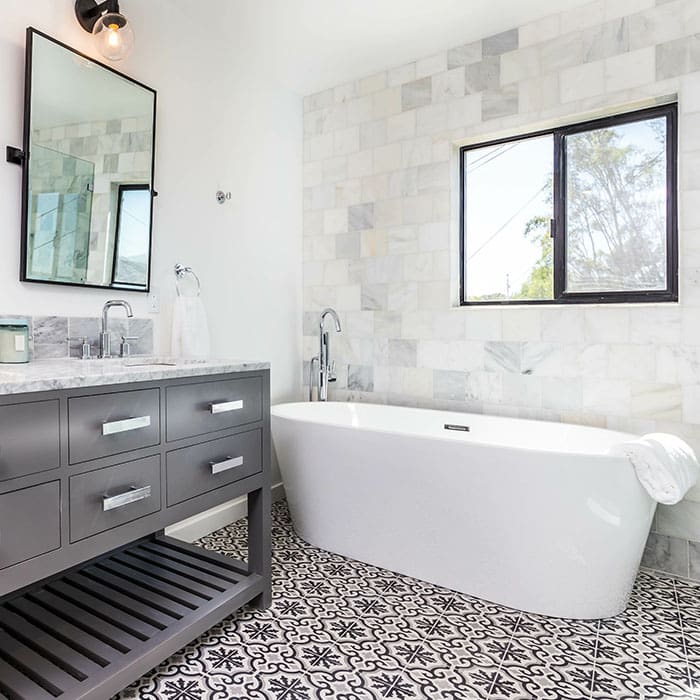
Tiles are an attractive and versatile covering that can be used on both the walls and floors of your home. They are available in an endless array of sizes, colors, and patterns, which allows you to get really creative with design. Tiles are crafted from a variety of materials, including ceramic, marble, porcelain, glass, and natural stone. There are tiles designed to be water-proof, and some designed to stand up to heavy levels of foot traffic. Before you purchase new tiles, it’s important to understand the differences between the most common types of tiles, and where they will perform best in your home.
Whether it be for a wall, backsplash, or floor, installing tile requires time and prep-work. If properly educated and prepared, laying tile can be easy—but doing it really well can be a challenge, which is why many people hire a professional to do the job. If you plan on installing tile on your own, it's important to educate yourself about the type of tile you will be working with, as well as the installation process itself. There are many resources available to help guide you in completing your project, from videos and literature, to basic classes at your local hardware store. For a successful outcome, we recommend that you take advantage of all of these resources.
Shop all Wall & Floor Tile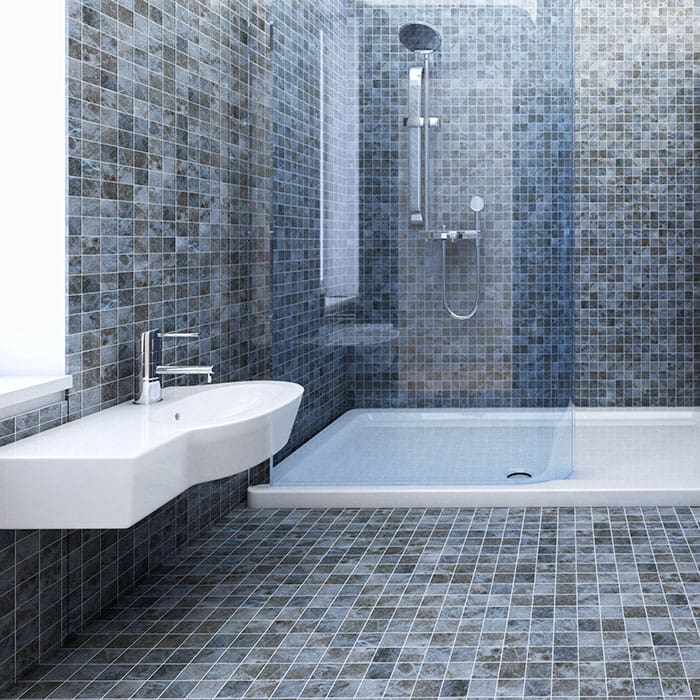
Ceramic
Ceramic is an affordable material made from high-fired white or red clay. It is sealed with a protective glaze that enhances its appearance and protects it from heat, moisture, and scratches. Ceramic has a glazed surface that makes it germ-resistant, stain-resistant, and very easy to keep clean. It works well in kitchens, bathrooms, and high-traffic areas of the home, and is a popular choice for floors. Ceramic tiles do chip more easily than porcelain, and are not the best choice for outdoor areas.
Installation & Care
Before installation, always thoroughly read and adhere to the installation instructions and maintenance guidelines provided by the manufacturer. Although ceramic is hard and durable, its glazed surface can still be dulled or damaged if not cared for properly. You can maintain your ceramic tile by sweeping and dusting it on a weekly basis. For cleaning, you can use appropriate tile cleaners, or a solution of warm water and gentle dish soap or detergent. Avoid using ammonia, bleach, or other harsh chemicals, which can strip ceramic tiles of their protective glaze, leaving them vulnerable to damage. Using abrasive tools can permanently scratch ceramic tiles.
Shop Ceramic TileInstallation difficulty level: Experienced / Professional
- Very affordable
- Water-resistant
- Stain-resistant
- Germ-resistant
- Slip-resistant
- Retains color well
- Available in numerous colors, finishes & styles

Marble
Marble is a gorgeous natural stone that is quarried from various regions around the world, and then cut into slabs for use in building construction. Prized for its elegance and durability, marble has a unique appearance marked by beautiful veins of color. Marble is an exquisite material that can be used for flooring, countertops, backsplashes, and tiles. It is water-resistant and can handle high temperatures very well, which makes it a great choice for kitchens. Marble is also UV resistant, so it maintains color well.
Installation & Care
Before installation, always thoroughly read and adhere to the installation instructions and maintenance tips provided by the manufacturer. Because marble is a porous material, it’s important that it be professionally sealed when installed. This will help prevent staining and other damage. Marble will last for many years if treated with right care. To keep it clean and lustrous, you can use a hand-duster or a dust mop as often as needed. For a more thorough cleaning, you can use appropriate marble cleaners, stone soap, or a mild solution of warm water and dish soap. When finished, rinse with clean water and wipe dry. Avoid using alkaline or acidic products, such as lemon, bleach, or vinegar, which can erode the surface of marble. Never scrub marble with an abrasive cloth or tool that could leave scratches.
Shop Marble TileInstallation difficulty level: Experienced / Professional
- Elegant
- Long-lasting
- Heavy weight composition
- Heat-resistant
- Water-resistant
- UV-resistant
- Available in a variety of color options
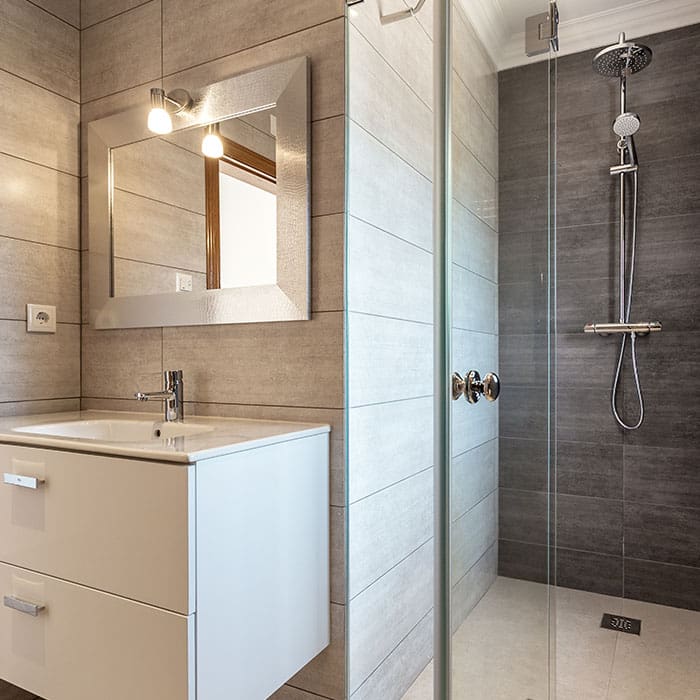
Porcelain
Porcelain is a high-quality, yet affordable, material made from very high-fired dense clay. It is considered to be the hardest and most durable type of tile available. One of the most important characteristics of porcelain, is that it is impressively water resistant, which makes it a great choice for bathrooms, laundry rooms, and high-traffic areas both inside and outside your home. This hardy tile also has an impervious surface that makes it hygienic and extremely easy to keep clean. Porcelain is stronger, hardier, and less porous than ceramic.
Installation & Care
Before installation, always thoroughly read and adhere to the installation instructions and maintenance tips provided by the manufacturer. Porcelain is one of the easiest materials to maintain, and you can keep it looking its best by lightly cleaning it with a soft cloth, broom, or dust mop. For a deeper cleaning, you can use a damp sponge or wet mop with commercial porcelain cleaner, or a solution of warm water and mild soap. When finished, rinse with clean water and air dry. Avoid using products with acids, chlorine, ammonia, or bleach, which can damage the color of the tile and grout. Never use cleaning products that are oil-based or have colorant. It’s best not to scrub porcelain with an abrasive cloth or tool.
Installation difficulty level: Experienced / Professional
- Affordable
- Incredibly durable
- Long-lasting
- Dense composition
- Waterproof
- Non-porous & stain resistant
- Handles cold temperatures
- Available in numerous designs & finishes
Benefits of Garage Flooring
In most households, the garage is used for more than just parking your car, it’s a place to do DIY projects, let the kids play, or get in a good workout. And because it gets so much use, your garage should be as functional and comfortable as possible. A quality garage floor will provide protection against scratches, stains, and chemicals, while also being able to stand up to the changing elements. And if your current garage floor is unattractive, new flooring offers an easy and inexpensive way to cover it up, while giving the space a more polished appearance. The most common types of garage flooring on the market today are made of durable rubber or PVC, and come in the form of tiles or floor mats that are easy to install and maintain. Read on to discover their many positive attributes and benefits.
Rubber
Rubber flooring has long been a staple in gyms, schools, and other high-traffic environments. But with recent improvements in appearance and performance, this multi-purpose flooring has become a popular and stylish option in both households and professional settings. Rubber is a highly durable material that is crack, stain, and water resistant, so it can handle all sorts of spills and liquids. And because it’s slip-resistant, rubber flooring offers a level of safety that other types of flooring simply can’t. Not only can it handle an incredible amount of foot traffic, it creates a floor that’s noise reducing, shock-absorbing, and soft underfoot. Typically sold in tiles or large mats, rubber flooring is available in numerous colors and designs to complement any style. Although rubber may be more expensive than other types of flooring, its many benefits make it a great long-term investment.
Installation & Care
Before installation, always thoroughly read and adhere to the installation instructions and maintenance guidelines provided by the manufacturer. When it comes to installation, not to worry—rubber is one of the easiest types of flooring to install. It’s typically available in large mats or interlocking tiles, both of which can be easily placed on top of an existing floor. Rubber flooring is easy to maintain, and can be cleaned with a sponge or mop, using a gentle solution of dish soap and water. It’s best to avoid using harsh cleaners or chemicals, which can cause deterioration and staining.
Shop Rubber FlooringInstallation difficulty level: Novice
- Extremely durable
- Crack-resistant
- Stain-resistant
- Slip-resistant
- Anti-microbial
- Shock-absorbing
- Noise buffering
- Easy DIY installation
PVC
PVC flooring is a synthetic material made of polyvinyl chloride, which is a durable type of plastic. This affordable flooring is lightweight and flexible, yet capable of handling the roughest conditions. It's resistant to water, mold, grease, oil, and other common chemicals, which makes it an excellent flooring option for a garage. Having a PVC floor allows you to work with all sorts of household chemicals without having to worry about damaging your floor. PVC garage flooring is commonly available in tight-fitting interlocking tiles that often have a textured pattern, and sometimes have drainage holes. You’ll find tiles in various colors that can intermingle to create unique patterns and designs.
Installation & Care
Before installation, always thoroughly read and adhere to the installation instructions and maintenance guidelines provided by the manufacturer. PVC floors are often called “instant” floors, because they are so quick and easy to install. The simple snap-together tiles can be placed over an existing floor without the use of nails or adhesives. And because PVC tiles are so lightweight, they can be easily disassembled for cleaning or relocation. You can maintain PVC flooring by cleaning it with warm, soapy water and a damp cloth or mop. Even though PVC is water-resistant, it's best not to let water stand on the floor. For stain removal, you can gently scrub the tiles with soapy water and a soft bristled brush. Please note that harsh scrubbing can damage the surface layer of the tiles.
Installation difficulty level: Novice
- Affordable
- Highly durable
- Chemical-resistant
- Water-resistant
- Mildew-resistant
- Lightweight
- Easy DIY installation
Helpful Terms
AC Durability Rating:
Abrasion Criteria (AC) refers to a laminate flooring's level of durability, which is defined by its resistance to abrasions, impact, and general wear and tear. After a product has been thoroughly tested, it is given an official AC Durability Rating that typically ranges from AC1 to AC5. The higher the number, the more durable the product. This rating system applies to both commercial and residential applications.
*In keeping with our strict quality standards, Costco only sells flooring products that are rated AC4 and above.
Acclimate
Acclimation is a process that allows flooring to adjust and become unified in the temperature and moisture level in your living space.
Fiberboard:
Fiberboard is a durable wood byproduct made of compressed wood fibers and synthetic resin. It is often used as a stabilizing core layer in laminate flooring.
Finish:
The finish on a floor is a protective topcoat intended to enhance appearance, prevent damage, and extend the life of the flooring.
Floating Floor:
Floating floors are available in easy-to-use interlocking planks or tiles that click together and stay in place, and require no nails, grout, or adhesives. This type of flooring is not secured to the subfloor underneath.
Lacquer:
Lacquer is a shiny finish, or sealant, applied to hardwood flooring to enhance appearance and protect the floor from water damage and scratches. It has a very similar appearance to varnish.
Melamine:
Melamine is a hard resin used to reinforce building materials like laminate and engineered wood. It is often used as a supportive back layer on laminate flooring, as well as a protective topcoat.
Tongue-and-Groove:
Tongue-and-groove refers to the way the edges of wood planks are cut to fit together. This method of flooring offers secure attachment between planks, while also allowing for flexible movement. The tongue-and-groove design is most often used on solid hardwood planks and engineered hardwood planks.
Underlayment:
Underlayment is used to strengthen the final finish surface, or provide the correct adhesion surface for adhesive used to install the final surface material. Underlayment can also be used as a slip sheet if the material is designed to not adhere to the base layer of the floor or siding.
Wear Layer:
Wear Layer ratings for residential use typically range from 6mil to 20mil with some applications for residential and commercial going up to 40 mil.
Wood Grain:
Every piece of natural wood has a visible growth pattern and texture that gives a specific appearance to the wood. This pattern is referred to as the grain.


